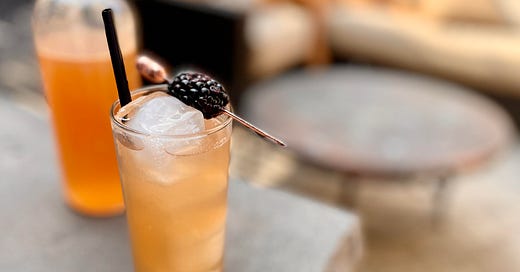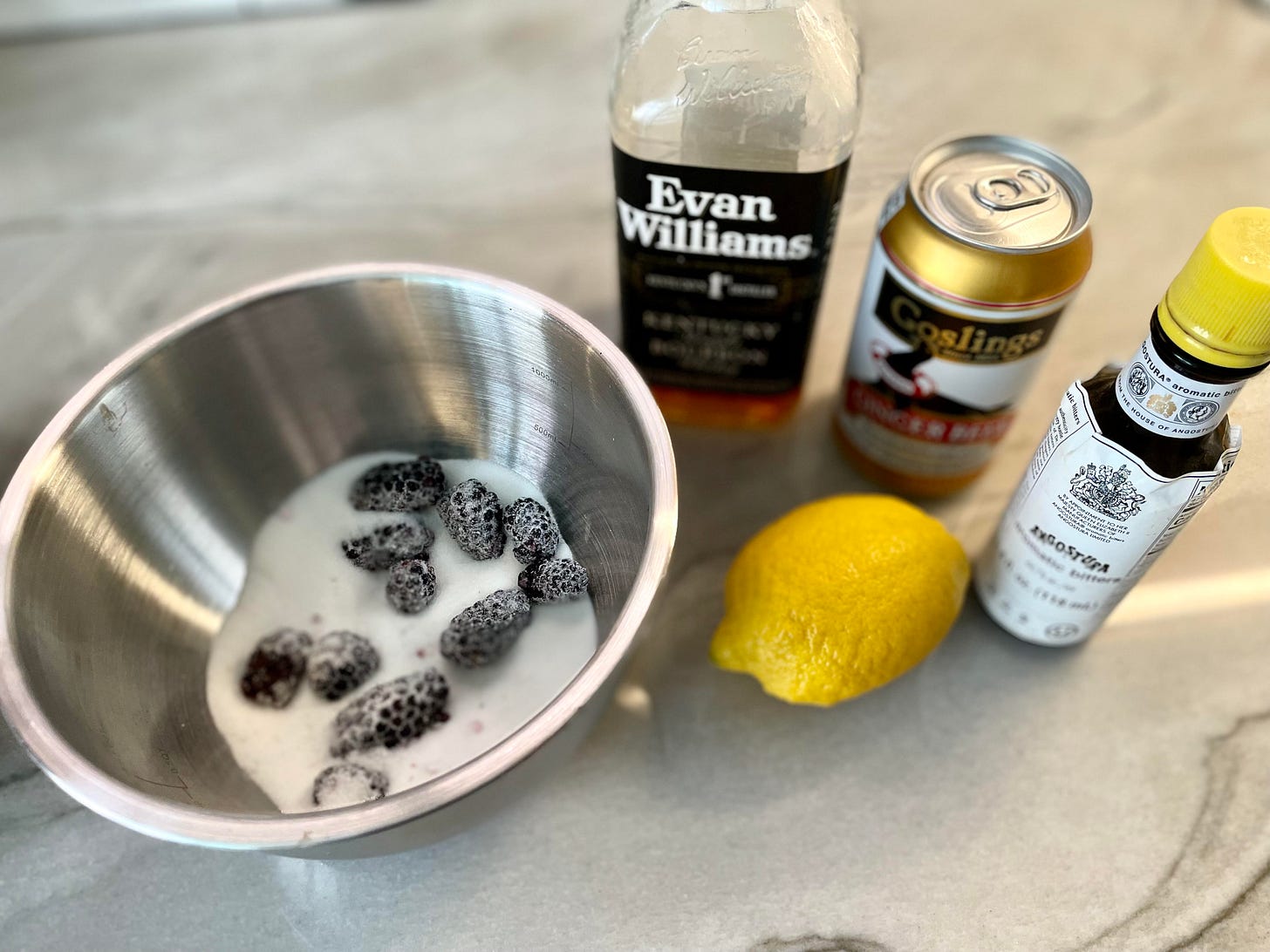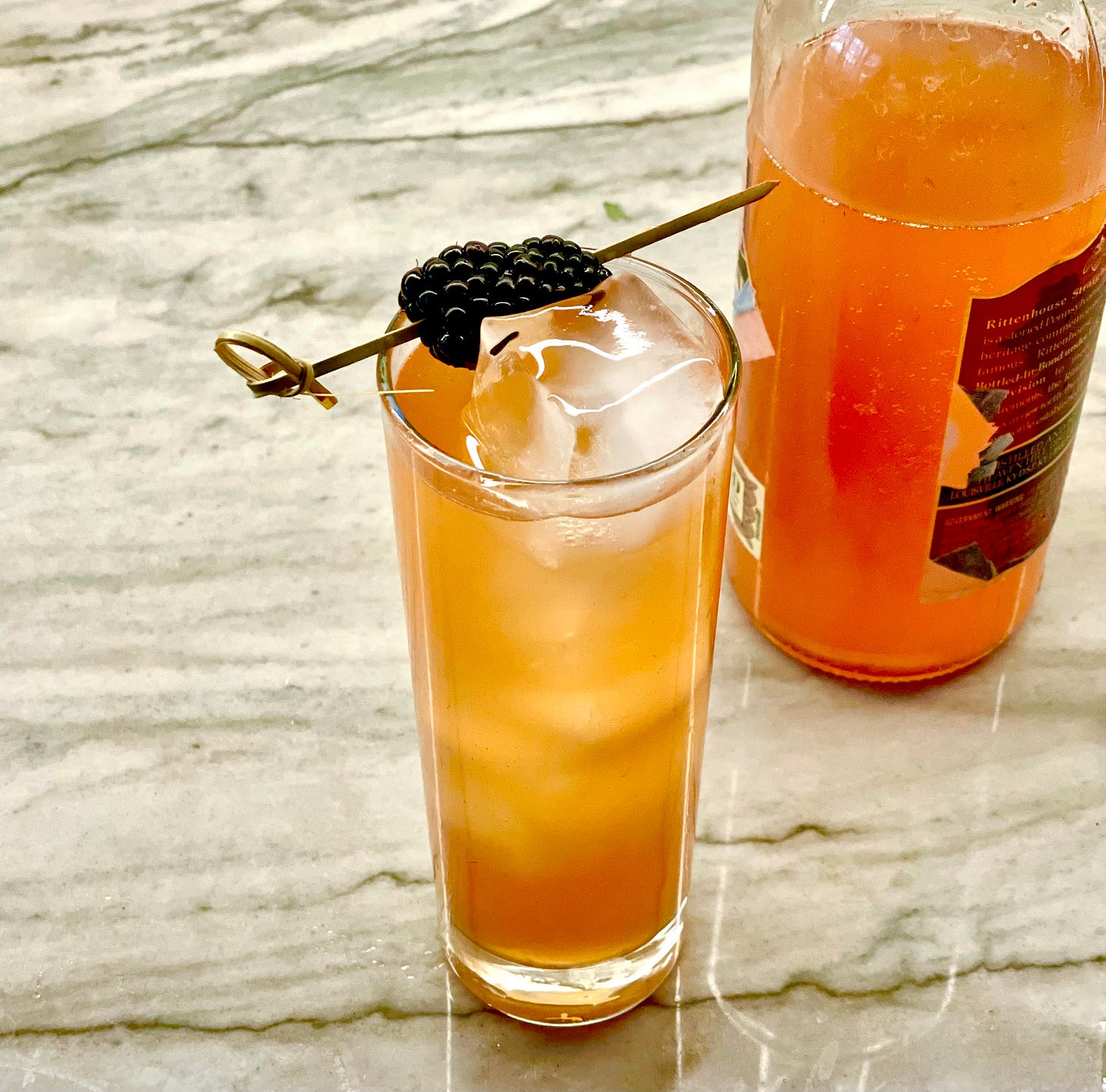Happy 4th of July. This week I want to talk about lemonade.
Lemonade is underrated.
It’s easy to make. It’s easy to batch. It’s easy to modify. And even in its simplest form, it’s incredibly satisfying — especially on a hot summer afternoon. More people should make lemonade. Lemonade should be a fixture in your life.
Lemonade is especially a great party beverage. When I host friends for cocktails, I almost always mix up a batch or two for people who don’t want to drink — or people who want to switch to something non-alcoholic after their first cocktail. It’s a great accompaniment for summer cookouts too: It pairs well with burgers, chicken, or ribs, just for starters, and it serves adults and kids equally well.
It’s also easy to adapt. You can easily add flavors, carbonation, or soda fizz. And of course you can make delicious boozy versions of varying complexity. Most boozy versions are also quite low in alcohol, meaning you can comfortably sip a few glasses over the course of an afternoon. Lemonade works for nearly every occasion.
So today we are going to learn to make a very basic lemonade. And then we are going to modify it into a scalable batched fancy cocktail version — specifically, a Blackberry Bourbon Ginger Lemonade.
The Rule of 7
Strictly speaking, lemonade is not quite a cocktail. But it has a lot in common with some of the cocktails we’ve looked at in this newsletter. Specifically, lemonade is a sort of no-booze sour made long by the addition of water or some other lengthening ingredient.
So in the same way that our Beer Margarita took a fairly basic Margarita structure and lengthened it with beer, lemonade takes sugar and lemon juice and lengthens it with water or something else.
As with so many cocktails, the tricks to making high-quality lemonade boil down to a few principles:
Use quality ingredients — in particular, fresh-squeezed lemon juice
Understand the underlying ratio
Measure accordingly
Drink it sooner rather than later
Virtually all of the lemonades I make rely on the same underlying seven-part ratio:
1 part sugar
1 part fresh-squeezed and strained lemon juice
5 parts water (or other lengthening ingredient)
You can whip up a single-serve version for yourself in just a few minutes.
Basic Lemonade
1 ounce sugar
1 ounce fresh squeezed and strained lemon juice
5 ounces water
INSTRUCTIONS
Combine all ingredients in a tall glass.
Using a barspoon (or, failing that, a knife or chopstick), stir rapidly until all ingredients are fully integrated.
Add ice, then drink through a straw.
See how good that is? How basic and almost primarily satisfying? I just made one of these for myself and downed the whole thing in about three gulps.
The best part is that this ratio scales more or less infinitely.
For a bigger batch, you could do the same thing using 1 cup of sugar, 1 cup of fresh lemon juice, and 5 cups of water.
Just combine in a mixing bowl or pitcher, then stir or whisk until integrated. With a big batch like this, you might want to chill the finished lemonade in the fridge for an hour or so before serving, but it’s not strictly necessary. You can always just pour it over ice.
Modify Your Lemonade
Once you master the basic formula, you can start to modify it, adding flavor, texture, and complexity.
The best place to start your modification is with the lengthener. One of the easiest adaptations is to switch out the water for club soda. It’s the same recipe, but now you have a lightly sparkling lemonade.
Want to give it a more complex flavor? Instead of club soda, try lengthening your lemonade with a flavored sparkling water like La Croix. To tamp down on the carbonation and the flavor of the La Croix, you might want to split the lengthener between water and La Croix — say, with three parts water, and two parts La Croix. Either way, congratulations. You’ve made, I don’t know, Beach Plum lemonade. The point is: You’re adding carbonated zest and flavor!
One of my go-to lengtheners is a split between tap water and ginger ale — two parts water and three parts ginger ale.
The water keeps the ginger ale from adding too much bite. And it gives the whole thing a very gentle effervescence—it still sparkles, but it doesn’t have the full frontal carbonated kick of a freshly opened can of soda.
This does add some sweetener to the mix from the ginger ale. But the structure still works, in roughly the same way that swapping club soda for beer works in the Americano Perfecto. It tastes, well, like a ginger lemonade.
I can hear the hardcore cocktail nerds grumbling in the background. Using ingredients like La Croix and ginger ale might sound fairly basic. Possibly it is basic.
But it’s also delicious and easy. You shouldn’t look down on using off-the-shelf ingredients like soda or flavored sparkling water when they work.
Now Add Bourbon and Berries
And of course you can use this same method to add alcohol. In general, I stick to swapping in one part booze for one part of the lengthener — any more and the alcohol starts to get in the way. This is supposed to be a boozy lemonade, emphasis on the lemonade, not booze with some added lemon and sugar. The booze is an accent, a team player, not the star of the show.
So, for example, a very basic bourbon lemonade would look like this:
1 part sugar
1 part fresh squeezed lemon juice
1 part bourbon (typically Evan Williams Black)
4 parts water or club soda
See how it’s still the same seven-part ratio? But now your basic lemonade tastes like a boozy, bourbon-y adult delight.
It is, however, a pretty basic boozy adult delight. Now, like I said, there is nothing wrong with basic. But for a fancy cocktail newsletter crowd, I do want to make it a little more sophisticated.
So we will also modify the sugar as well — in this case by adding blackberries.
There are a bunch of potential ways to do this, but the easiest is just to cover a bunch of blackberries in sugar for four to six hours prior to making your lemonade. No need to macerate them or heat them into a syrup. Instead, you just combine blackberries and sugar in a bowl several hours before you plan to make the lemonade. During this time, the sugar will absorb some of the blackberry flavor. You’ll just need to remove the blackberries from the final mix. It’s a lot like the lemon peel-and-sugar oleo saccharum we used in last year’s 4th of July drink, the Philadelphia Fish House Punch.
The next thing we are going to do is split the five-part lengthener portion between three different ingredients. Instead of five parts water, we will use
1 part bourbon
1 part water
3 parts ginger beer
Ginger beer has a somewhat less sweet, less dry taste than ordinary ginger ale, and, in most cases, a little more gingery heat. That’s going to give the final drink just a little more of a spicy kick. The split with water, however, keeps the whole thing mellow and together. As in other cocktails, dilution from water helps integrate the various flavors.
(For the ginger beer, I’ve mostly used Goslings, which you can order from Amazon. But I’ve also made this with Trader Joes Brewed Ginger Beer, and it works quite well. If you really can’t find ginger beer, you can substitute ginger ale though you should expect it to be a little crisper and a little sweeter. But next week’s drink will call for ginger beer as well, so try to find some if you can.)
Finally, I want you to add one more ingredient: bitters.
You don’t typically find bitters in lemonade, but I often add small amounts to batches, simply because they are such an efficient way of adding or modifying flavor. At times I’ve made a very basic lemonade where the only modification is the inclusion of a few dashes of Fee Bros. Grapefruit Bitters, which add a citrusy complexity.
For this drink, however, I specifically want you to use Angostura Aromatic Bitters, the most common of all cocktail bitters.
Remember that bitters are quite strong. Just a little bit goes a long way, especially in large batch drinks. You want the bitters to be subtle. Just a handful of dashes per batch will deliver plenty of Angostura’s spice-rack flavor.
The bitters and the blackberry accentuate each other, but the whole array of flavors really work together. It’s the combination of the bitters, blackberry, bourbon, and ginger that transforms this from a kind-of-basic-seeming lemonade to sophisticated sipping cocktail.
The result is a gently bubbly, fruity-sweet, pleasantly complex, easy to drink, light-and-mildly-boozy beverage that will keep your and your friends good company over a long summer weekend.
It’s lemonade — but it’s better than lemonade.
This drink will be best on the day you make it, but if you bottle it and store it in your refrigerator, it should be good for another three or four days.
What sort of container you store it in is up to you. But I have specifically designed this recipe to fit into a standard 750 ml liquor bottle, so you can use a (cleaned out) empty if you have one.
Bottles with plastic screw tops work best. Regular readers will not be surprised to learn that I am particularly fond of empty Rittenhouse Rye bottles, which I always save after use. Just clean them out and, if you want, scrape off the label, and you have an empty bottle with a convenient screw top that will fit easily into most refrigerators.
So here’s the recipe.
Blackberry Bourbon Ginger Lemonade
6 dashes Angostura Aromatic bitters
10-12 blackberries
4 ounces sugar
4 ounces water
4 ounces bourbon (preferably Evan Williams Black)
12 ounces (so one can or one bottle) ginger beer
INSTRUCTIONS
Combine sugar and blackberries in a bowl. Gently shake the bowl to cover blackberries in sugar. Let sit for 4-6 hours.
Pick the blackberries out of the bowl. (Alternatively, you can strain them out later.) Reserve blackberries in a separate bowl for for garnish.
Add lemon, water, bitters, and bourbon to sugar bowl, then whisk to integrate. You want to make sure there is no sugar sludge left on the bottom.
Add ginger beer to mix, pouring carefully to avoid spillover fizz, then briefly stir to integrate.
Use a funnel to pour into an empty 750ml liquor bottle (if using). Store final mix in the refrigerator.
Serve over ice with a skewered blackberry for garnish. Makes 4-6 servings.
Why Not Other Berries? Why Not Other Booze?
This is a good way to modify lemonade. But it isn’t the only way. The underlying structure is incredibly flexible.
But if you’re going to adjust this drink, my first suggestion would be to take the final recipe and switch out the booze and the berries.
I made a blueberry and brandy version that was quite good, but there are many possibilities: Instead of blackberries and bourbon, try raspberries and tequila, or strawberries and gin. Although I haven’t tried it, you could probably move beyond berries to other fruits: Why not try a watermelon mezcal version, an apple rye version, or, for the adventurous, grapefruit and Cynar? (If you go with Cynar, maybe skip the Angostura bitters.)
The point, as always, is that this is a template as much as a recipe. You can make this specific drink. But you can also make it your own.
Enjoy the weekend!
***







How would you adjust the water and sugar ratios if using simple syrup? Any benefits or drawbacks to that?
Looking forward to trying this! Seems like lemon peel would work well in the sugar mix. Or would that clash with the blackberry?